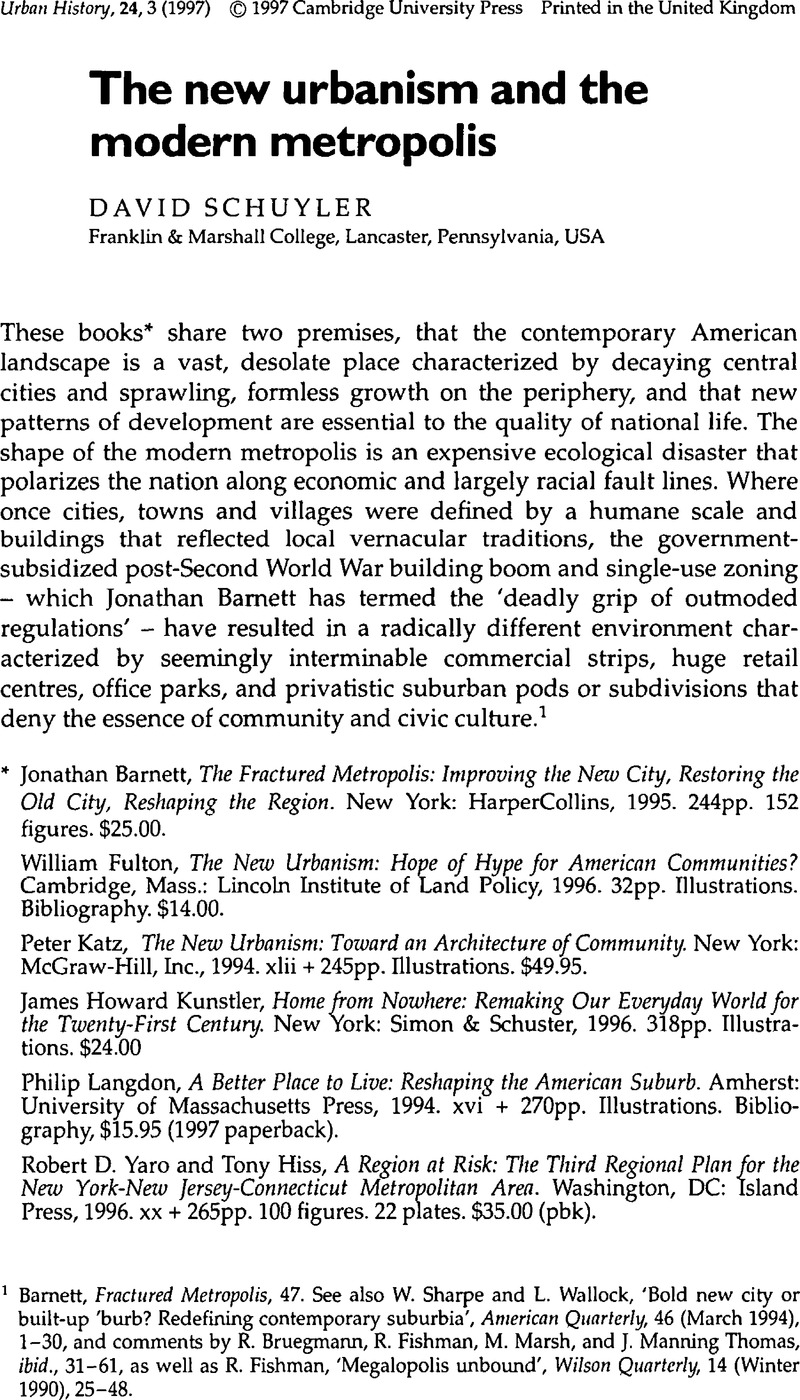Article contents
The new urbanism and the modern metropolis
Published online by Cambridge University Press: 09 February 2009
Abstract

- Type
- Review Essay
- Information
- Copyright
- Copyright © Cambridge University Press 1997
References
1 Barnett, , Fractured Metropolis, 47Google Scholar. See also Sharpe, W. and Wallock, L., ‘Bold new city or built-up 'burb? Redefining contemporary suburbia’, American Quarterly, 46 (03 1994), 1–30CrossRefGoogle Scholar, and comments by R. Bruegmann, R. Fishman, M. Marsh, and J. Manning Thomas, ibid., 31–61, as well as Fishman, R., ‘Megalopolis unbound’, Wilson Quarterly, 14 (Winter 1990), 25–48.Google Scholar
2 Duany, A. and Plater-Zyberk, E., ‘The second coming of the American small town’, Wilson Quarterly, 16 (Winter 1992), 19–48Google Scholar; ‘The Ahwahnee Principles 1991’, in Fulton, The New Urbanism, 6Google Scholar; Rymer, R., ‘Back to the future: Disney reinvents the company town’, Harper's, 293 (10 1996), 65Google Scholar. See also Krieger, A. and Lennertz, W. (eds), Andres Duany and Elizabeth Plater-Zyberk: Towns and Town-Making Principles (Cambridge, Mass., 1991).Google Scholar
3 Calthorpe, P., The Next American Metropolis: Ecology, Community, and the American Dream (Princeton, 1993), 23–4.Google Scholar
4 Duany, and Plater-Zyberk, , ‘Second coming of the American small town’, 39–41Google Scholar; Calthorpe, , Next American Metropolis, 24Google Scholar. See also Jenkins, V. Scott, The Lawn: A History of an American Obsession (Washington, DC, 1994).Google Scholar
5 Langdon, , Better Place to Live, 27–61Google Scholar; Barnett, , Fractured Metropolis, 212–13Google Scholar; Kunstler, , Home from Nowhere, 127–9.Google Scholar
6 Duany, A. and Plater-Zyberk, E., ‘The neighborhood, the district, and the corridor’, in Katz, New Urbanism, xvii–xxGoogle Scholar; Fairfield, J.D., The Mysteries of the Great City: The Politics of Urban Design 1877–1937 (Columbus, 1993), 204–14Google Scholar (Harrison is quoted on 209); Silver, C., ‘Neighborhood planning in historical perspective’, Journal of the American Planning Association, 51 (Spring 1985), 161–74CrossRefGoogle Scholar; Gillette, H. Jr, ‘The evolution of neighborhood planning: from the Progressive Era to the 1949 Housing Act’, Journal of Urban History, 9 (08 1983), 421–44CrossRefGoogle Scholar; Sies, M. Corbin and Silver, C. (eds), Planning the Twentieth-Century American City (Baltimore, 1996), 8–9, 463–5, passim.Google Scholar
7 Calthorpe, , Next American Metropolis, 24Google Scholar, passim; Krieger, and Lennertz, , Andres Duany and Elizabeth Plater-Zyberk, 21–4, 96–103Google Scholar; Kunstler, , Home From Nowhere, 136–49.Google Scholar
8 Calthorpe, , Next American Metropolis, 11, 16–17, 31–4, passim.Google Scholar
9 Schuyler, D. and Censer, J. Turner (eds), The Papers of Frederick Law Olmsted, vol. VI: The Years of Olmsted, Vaux & Company 1865–1874 (Baltimore and London, 1992), 29–32, 273–90Google Scholar; Schaffer, D., Garden Cities for America: The Radburn Experience (Philadelphia, 1982), 145–88Google Scholar; Stein, C.S., Toward New Towns for America (Cambridge, Mass., 1989; 1st pub. 1957)Google Scholar; Mumford, Lewis, The City in History: Its Origins, Its Transformations, and Its Prospects (New York, 1962), plate 51.Google Scholar
10 See, for example, Gruen, V., The Heart of Our Cities. The Urban Crisis: Diagnosis and Cure (New York, 1964)Google Scholar, and two important assessments of his work: Gillette, H. Jr, ‘The evolution of the planned shopping center in suburb and city’, Journal of the American Planning Association, 51 (Autumn 1985), 449–60CrossRefGoogle Scholar, and D.R. Hill, ‘Sustainability, Victor Gruen, and the cellular metropolis’, ibid., 58 (Summer 1992), 312–26.
11 See Fishman, R., ‘The regional plan and the transformation of the industrial metropolis’, in Ward, D. and Zunz, O. (eds), The Landscape of Modernity: Essays on New York City, 1900–1940 (New York, 1992), 106–25Google Scholar; Johnson, D.A., ‘Regional planning for the great American metropolis: New York between the world wars’, in Schaffer, D. (ed.), Two Centuries of American Planning (London, 1988), 167–96.Google Scholar
12 On the importance of Coral Gables, see Duany, and Plater-Zyberk, , ‘Second coming of the American small town’, 30, 36–7Google Scholar, and Scully, , ‘The architecture of community’, in Katz, New Urbanism, 226–7.Google Scholar
13 Mumford, L., ‘Botched cities’, American Mercury, 18 (10 1929), 143–50Google Scholar; idem, ‘The intolerable city’, Harper's, 212 (02 1926), 283–93Google Scholar; and idem, ‘The wilderness of suburbia’, New Republic, 28 (7 09 1921), 44–5.Google Scholar
14 Lewis, S., Main Street (New York, 1961; 1st pub. 1920), 257Google Scholar. Babbitt defended the archtypal houses of suburban America from criticism, asserting: ‘There's no other country in the world that has such pleasant houses. And I don't care if they are standardized. It's a corking standard!’ (p. 85)Google Scholar. See also Doren, C. Van, ‘Contemporary American novelists: X. The revolt against the village: 1920’, Nation, 113 (12 10 1921), 407–12Google Scholar, and Radford, G., Modern Housing for America: Policy Struggles in the New Deal Era (Chicago, 1996), 17–57.CrossRefGoogle Scholar
15 Calthorpe, , ‘The region’, in Katz, New Urbanism, xiGoogle Scholar; Scully, ‘Architecture of community’, in ibid., 221; Barnett, , Fractured Metropolis, 87.Google Scholar
16 See, for example, Thompson, J.W., ‘Of grids and green fields’, Landscape Architecture, 86 (02 1996), 88–99Google Scholar; Marshall, A., ‘Suburb in disguise’, Metropolis, 16 (07-08 1996), 70–1, 100–3Google Scholar; Daniels, T.L., ‘Where does cluster zoning fit in farmland protection?’, APA Journal, 63 (Winter 1997), 129–37Google Scholar; and, ‘Seaside & the real world: a debate on American urbanism’, Any: Architecture New York, 1 (07-08 1993), 6–9, 28–35.Google Scholar
17 Wilson, W.J., When Work Diasppears: The World of the New Urban Poor (New York, 1996).Google Scholar
18 HRH The Prince of Wales, A Vision of Britain: A Personal View of Architecture (London, 1989), 146.Google Scholar
19 Kunstler, , Home From Nowhere, 189.Google Scholar
- 16
- Cited by


